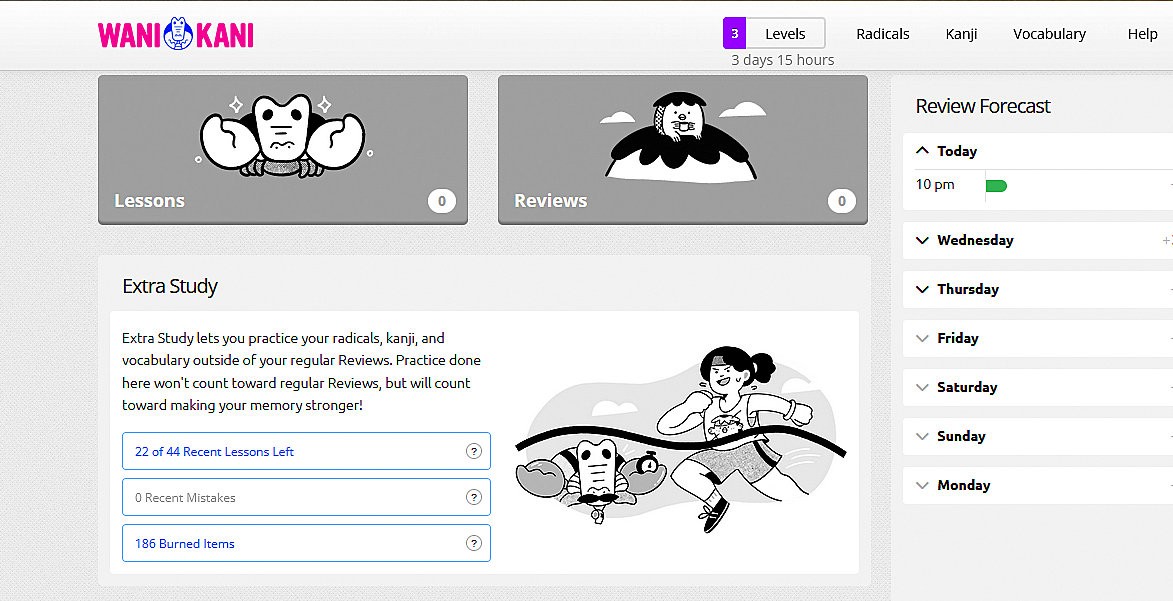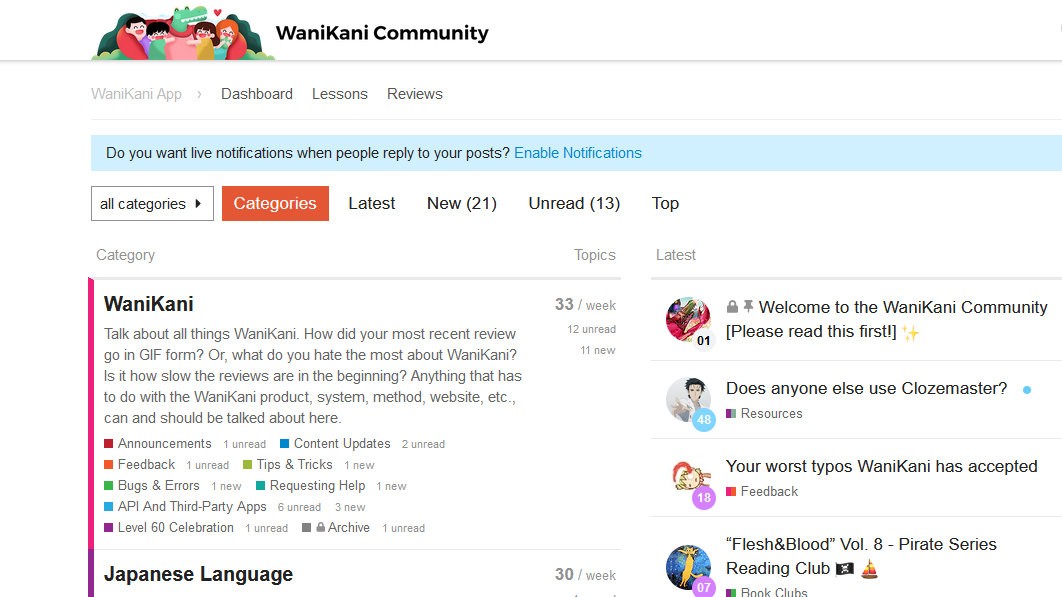If you have been studying Japanese for a while and often search for apps, websites, and foreign courses (most in English), then you have probably heard of Wanikani.
Wanikani is a Japanese study platform focused on learning kanji and vocabulary using SRS (Spaced Repetition System) or "Sistema de Repetição Espaçada" (the same as Anki), which aims to improve memorization capacity during studies, mainly through mnemonics (phrases that use mental associations with pronunciations, little stories, images, or other similar words to remember the required information).
The site has a level scheme that simulates a video game. Initially, it is possible to use Wanikani for free up to level 3. After that, it is necessary to pay to proceed to the next levels. There are 60 levels in all, and you can see your progress as lessons and revisions are completed.
In this article, we'll look at what this study platform is and whether or not it's worth paying for it to learn Japanese. We will give suggestions for other tools as well.
Read More:
- Study Guide for Learning Japanese
- Japanese Club - Suki Desu's Online Japanese Course!
- How many kanji do Japanese people need to know?
Table of Content
What is Wanikani?

According to the official website, Wanikani is a Japanese language learning web application with one simple goal: to teach you most of the 2,000 jōyō kanji (meanings and readings) as well as 6,000 vocabulary words within one to two years..
“By utilizing spaced repetition, mnemonic techniques, and interleaving them, we have created one of the fastest and simplest systems for people who want to learn to read Japanese” (Transcript from the official website).
Wanikani is divided into three categories with 60 levels each and 6 subcategories. The three main divisions are: Radical (部首), Kanji (漢字), and Vocabulary (単語). Radical is represented by the color blue, kanji by the color pink, and vocabulary by the color purple.
Each of them has 6 sub-ranks: Pleasant (快): Levels 1 to 10, Painful (苦): Levels 11 to 20, Death (死): Levels 21 to 30, Hell (地獄): Levels 31 to 40, Paradise (天国): Levels 41 to 50 and Reality (現実): Levels 51 to 60.
In addition, there are also 6 levels of SRS (Spaced Repetition System), which show how much a item has been seen and learned. They are: Apprentice (Apprentice), Guru, Master (Master), Enlightened (Enlightened) and Burned (Burned). Upon reaching “Burned” the letter is “burned”, that is: it means that you have gone through all the stages of SRS and probably memorized the content of the letter.
The program is divided into lessons and revisions and there is a timeline with forecasts for future revisions.
Wanikani is a creation of Jaered Koichi, founder of the blog Tofugu. Currently, Tofugu and Wanikani are very successful companies in the field of Japanese language learning. Tofugu is a blog that discusses topics about Japanese culture and the Japanese language. The art style of the site is similar to that of Wanikani, featuring traditional colorful drawings.
To use Wanikani, you can choose between using the platform for free up to level 3 or paying for a monthly, annual or lifetime plan to release the rest.
A curiosity is that there is a mascot within Wanikani, known as Crabigator, which is a mix of alligator and crab: aligator (alligator) + crab (crab). See below for his illustration:

My opinion
I have been using Wanikani since 2021 and see both positive and negative points. Among the advantages, it's worth mentioning the possibility of learning the most important Kun'yomi and On'yomi readings of about 2,000 ideograms and more than 6,000 words. The fact that the platform is always being updated, with frequent updates and improvements, is also something to praise. Another attraction is the community. Many students share user scripts that help improve various aspects of WK.
In terms of motivation, Wanikani is also extremely beneficial. By having a system of levels, the user is always motivated to enter the platform daily to make their revisions. In addition to learning kanji and vocabulary, it is also necessary to study radicals (parts/strokes that make up kanji) within the WK lesson schedule. For those who don't know English, it is possible to create synonyms in English for each radical, kanji or word (mainly through user scripts, suggested in the community forum).

Other advantages:
- Funny.
- Spaced Repetition System.
- Content-rich platform.
- Division by colors: Kanji = Pink, Vocabulary = Purple and Radical = Blue.
- Attractive layout.
- Extra Study Section.
- Active community.
- Userscripts (Userscripts).
- Context Sentences.
Disadvantages:
- Difficulty for students who do not know English or are not familiar with using user scripts or browser tools.
- Some mnemonics are not very helpful in understanding the readings and meanings.
- Prices for annual and lifetime plans are a bit expensive (charged in dollars).
- It takes time and daily effort.
Anyway, if you want to learn the main readings and meanings of the 2,000 kanji in the basic list, Wanikani will help you with that. But if your goals with the Japanese language go beyond that, I think it should be better to use WK only as complementary material, as it does not cover in depth topics such as grammar, listening, pitch accent or conversation.
To learn grammar, listening, pronunciation, and conversation, it is recommended to acquire a complete course like Japonês Club.
We recommend that you also read:
Alternatives
Below I suggest alternatives for those who cannot pay or do not want to use Wanikani. Most options are in English. Some platforms/applications are paid while others are completely free, as is the case with Kanji Damage.
- Kanji Garden
- KameSame
- Kanji Damage
- Kanji Kohii
- Anki
- Memrise
- Quizlet
- Bunpro
- Marumori
- Migaku
- Kitsun.io
- Japanese.io
- Torii
- Houhou SRS
- Glossika
- Kanshudo
- Brainscape
- Study Stack
- Drops
- Tanoshii Japanese
- Duolingo
- Busuu
- IPPO!
What's up? Did you like the article? Share with your friends on social networks!
